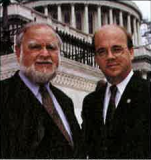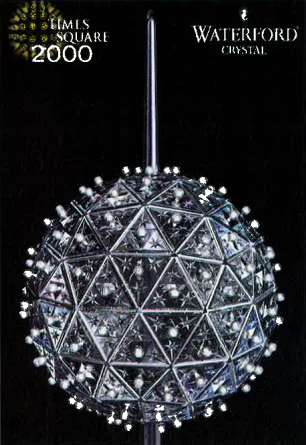Waterford’s Crystal Ball to Cap the Celebration of the Century
To commemorate the 100-day countdown until the millennium the Times Square Business Improvement District President Brendan Sexton and Countdown Entertainment President Jeffrey Strauss unveiled the new Times Square New Year’s Eve Ball in the Bronx, NY on September 23.
Created by Waterford Crystal, the new ball will be the centerpiece to the millennial celebration, Times Square 2000, The Global Celebration at the Crossroads of the World. Weighing 1,070 pounds, the ball will be covered in a hand-crafted original Waterford design. The “Star of Hope” crystal design will consist of 504 crystal triangles, each containing a central circle and seven-pointed star. The central circle represents the earth while the star’s seven points represent each of the seven continents.
The millennial celebration will include a 24-hour multi-media celebration of all cultures of the world and will begin at 7 a.m. Eastern Standard Time, when the New Year arrives in the South Pacific. The celebration is expected to draw more than 1.5 million visitors to Times Square, with millions more watching the festivities on television.
Laid to Rest
One of the Civil War’s final mysteries was solved recently when the remains of the first Confederate crew of the submarine H.L. Hunley were discovered in Charleston, South Carolina. The graves of the four crewmen, believed to be Irish immigrants, were unknown for more than half a century until they were uncovered underneath the Citadel’s Johnson-Hagood stadium, along with the graves of 23 other Confederate sailors and marines.
The crew members, five in all, drowned on August 29, 1863 when the sub sank while preparing for its trial voyage. Their remains were given a hasty burial in what was then Charleston’s mariners’ graveyard, stacked one on top of the other in oversize coffins. The crew members were Frank Doyle, John Kelly, Michael Cane, Nicholas Davis and Absolum Williams. Experts still do not know which one is the missing fifth crew member but presume it is Williams and believe his remains were claimed by his family or buried elsewhere.
The cemetery was demolished in 1948 to make way for Johnson-Hagood stadium. A clerical error apparently resulted in the headstones being moved, but not the graves. The remains of the four crewmen will be interred with full military honors next spring in Magnolia Cemetery in Charleston.
Moakley, McGovern and Enemies of War
The civil war in El Salvador killed 75,000 people during the 1980s, but the murders discovered on the morning of November 16, 1989 were particularly shocking — both because of the brutality and the victims.
Six Jesuit priests, their housekeeper and her daughter had been dragged outside in the middle of the night and shot in the head. The killings soured the U.S. government on decade-long support of El Salvador’s government after a Congressional probe — led by two Irish Americans from Massachusetts — implicated officials at the highest levels of the Salvadoran military.
Enemies of War, a film by Esther Cassidy narrated by Martin Sheen, tells the story of the killings and of the U.S. Congressional investigation pressed by Representative Joe Moakley and his then staffer, James P. McGovern, now a representative himself. The two traveled to Los Angeles for a July 16 preview screening at the Catholic National Justice Jubilee at the University of California Los Angeles.

The film not only covers the murders and the investigation, but examines the oppressive poverty and government violence that led to an armed insurgency in El Salvador from 1981 to 1993. Enemies is propelled by interviews with the blunt-speaking Moakley and McGovern (Moakley’s point man on the murder investigation), who describe cover-ups by Salvadoran military officials and their supporters in the U.S. State Department.
In Enemies, McGovern tells of a confrontation between the congressman and a Salvadoran general who was later found to have participated in planning the Jesuits’ murders — but claimed in a meeting to know nothing of the incident. Moakley was equally forceful with the U.S. State Department, threatening to bar officials from a fact-finding trip to El Salvador unless they produced the correspondence Moakley and McGovern needed to move the investigation forward. The State Department ultimately complied.
McGovern, now a Democratic representative from Worcester, Massachusetts, is as disinclined as his then boss to mince words. In Enemies of War he talks about the policies of the Reagan and Bush Administrations that sent over $5 billion to the government of El Salvador, a country the size of his home state. “We stood toe-to-toe with some of the biggest creeps in the hemisphere,” he says incredulously. A United Nations report holds the Salvadoran government responsible for 85 percent of the deaths during the war.
Both representatives had plans to attend the 10-year commemoration of the Jesuits’ deaths in El Salvador in November. Enemies of War is being considered for broadcast by PBS and is being reviewed by foreign broadcast outlets in 20 countries. It was produced with support from the Catholic Communication Campaign.♦
Hillary Shines at Emerald Event
 First Lady Hillary Clinton was the surprise guest at the Emerald Isle Immigration Center annual dinner in Astoria, Queens. The First Lady (pictured at the dinner) rubbed shoulders with 500 attendees, including local community leaders, and praised the Irish American community for their ongoing support of the peace process.
First Lady Hillary Clinton was the surprise guest at the Emerald Isle Immigration Center annual dinner in Astoria, Queens. The First Lady (pictured at the dinner) rubbed shoulders with 500 attendees, including local community leaders, and praised the Irish American community for their ongoing support of the peace process.
Jeanie Johnston to set sail again
In April 2000, a replica of the Jeanie Johnston, one of the most famous of the Irish 19th century emigrant vessels, will make her historic trans-Atlantic Millennium Voyage to North America, retracing the route taken by the original emigrant ships.
Constructed in Quebec in 1847, the Jeanie Johnston was a triple-masted barque that transported several thousand emigrants from Blennerville, the old Port of Tralee, to Baltimore, New York and Quebec. Built by famed shipbuilder John Munn, it was copperfastened, 150 feet in length and weighed 408 tons.
The ship had a remarkable safety record and, unlike the disease-ridden coffin ships of the famine period, never lost a passenger to disease or the sea. It was owned by John Donovan & Sons, and was captained by James Attridge. It was one of the rare ships that employed a doctor on board.
In December, 1848 — at the height of the potato famine — the Jeanie Johnston transported food supplies to Ireland and returned to Baltimore in March, 1849 with a full complement of 200 passengers. In all, the vessel made 16 crossings.
The ship’s replica is currently under construction at Blennerville, County Kerry. Work at the shipyard commenced in 1997, and President Mary McAleese laid the keel on May 5, 1998, exactly 150 years after the maiden voyage of the Jeanie Johnston from Tralee to North America. In an attempt to increase cross-border relations, the project has recruited teenagers from Northern Ireland and the Republic of Ireland to help build the ship.
President Clinton has donated the ship’s bell, and has promised to greet the ship on her arrival in the United States. The ship will spend nine months in North America including Canada before returning to Ireland in 2001, to be berthed at Blennerville Quay, Tralee, County Kerry.
“This will go far beyond the history of the Irish in this country,” said Hugh Carey, former governor of New York, at a kick-off event at the 21 Club in New York City. This trans-Atlantic voyage, he pointed out, serves to remind all Americans of the role immigrants have played, and still play, in this country’s development.
Linked to the Jeanie Johnston will be the Irish 19th Century Emigration Center, also located at Blennerville. It will contain computerized listings on the estimated six million Irish who emigrated to the United States and Canada in the last century.
The ship’s construction and Millennium Voyage are being sponsored by Élan Corporation, plc. -Sarah Buscher♦


Leave a Reply